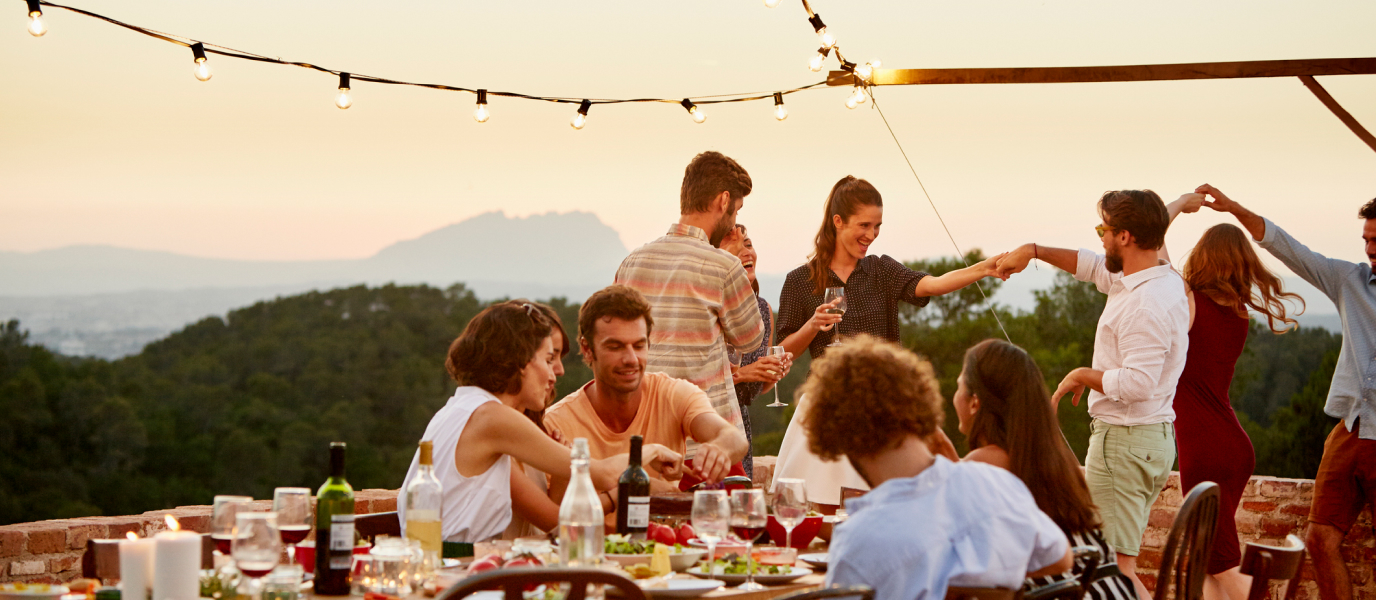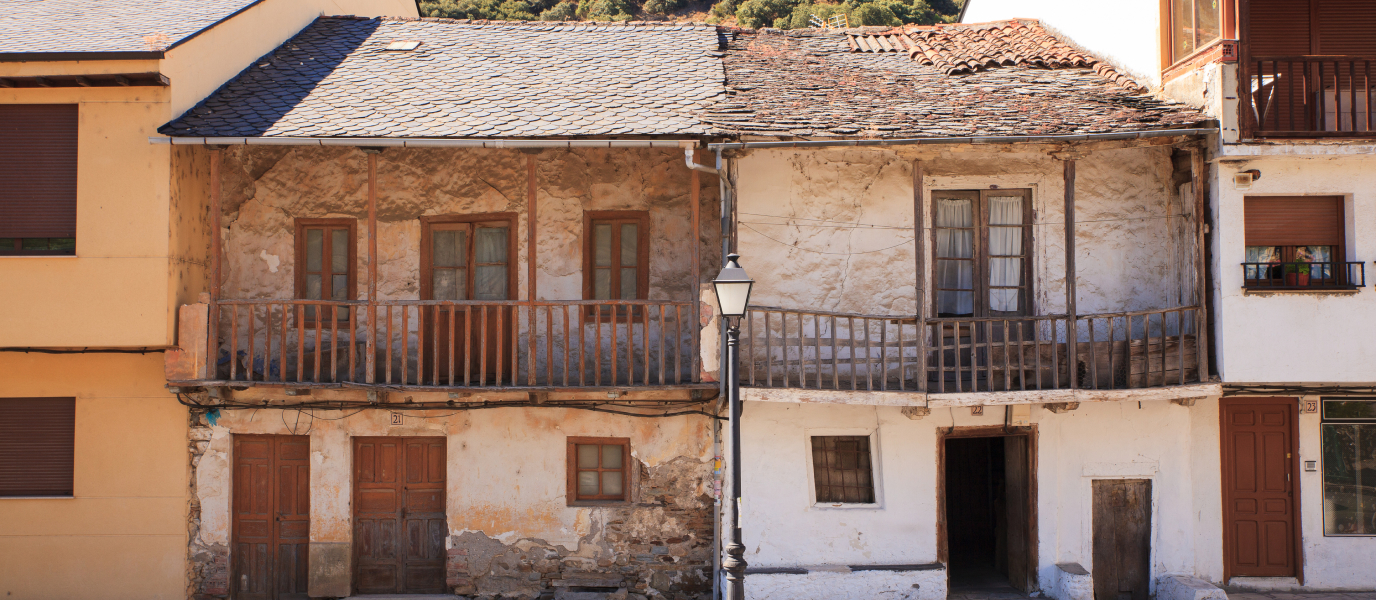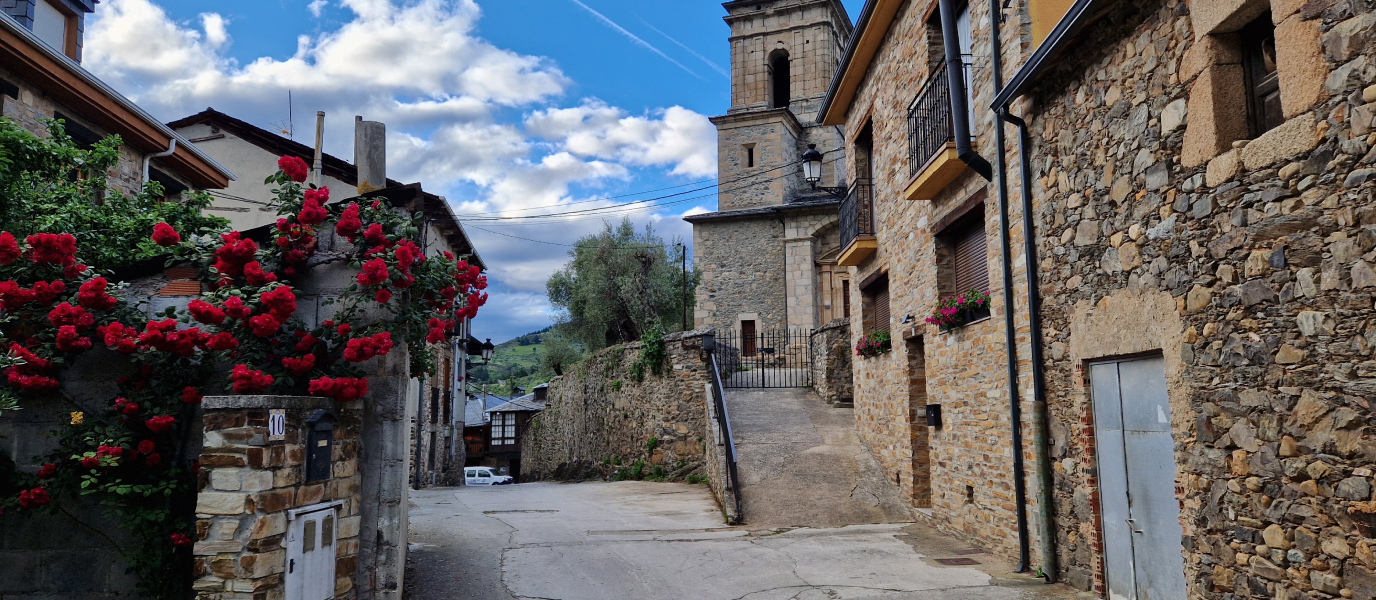The Las Médulas natural monument is a beautiful open wound after years of massive mining by the Romans in search of gold. For more than two centuries, the earth was turned over to extract gold, leaving a landscape that could be considered almost lunar. The area is full of viewpoints, grottoes and giant caves that give visitors the sensation of being in a supernatural space.
Enclosing the valley of the river Sil, the origin of its name is not well known, although everything seems to indicate that Las Médulas refers to the piles of straw that were very common in the region. Other scholars, however, link it to the Latin word ‘metalla’ (metals) and it has also been linked to Mount Medulio, where the Asturian and Cantabrian warriors resisted the Roman siege and ended up committing suicide before being defeated.
Since 1997, it has been a World Heritage Site and one of the most visited natural monuments in Spain.
The context: Las Médulas as a World Heritage Site
This area was declared a National Monument in 1931 and a Cultural Heritage Site in 1996 due, among other features, to its archaeological interest. Las Médulas is a key testimony to how the Romans operated these mines and how the earth reacts to centuries of massive work. In 1997, UNESCO declared it a World Heritage Site, becoming the first European landscape to receive this recognition. In 2002, it was declared a Natural Monument.
Nothing seems simple in Las Médulas, not even its declaration as a Heritage Site; and, as an anecdote, it is worth noting that Thailand, Finland and Germany opposed this, considering that the landscape is the result of the destructive activity by humankind.
History of the site
The Romans arrived at Las Médulas during the time of Octavian Augustus, between 29 BC and 19 BC. At that time, this region was inhabited by Asturian farmers and stockbreeders, who were already gold panning in the rivers.
The Romans soon realised that the golden metal could be found in its free-state area and turned Las Médulas into an open-air mine using the ‘ruina montium’ technique, i.e. the wrecking of the mountains that has given rise to today’s landscape.
They filled the upper parts with canals through which the water brought from snowfields and rivers flowed and ended up cracking the mountain and knocking it down. The debris from the hills fell into the washers where the soil was separated from the gold.
That is why the landscape that you see today goes beyond the perforated mountain peaks and you can visit lakes and lagoons that that originated in this movement of water, including over 400 kilometres of canals, bridges, aqueducts, causeways, roads, etc.; this engineering work is considered to be one of the most complex of its time enabling the gold to get to Rome, where it was used mainly to mint coins.
The Roman writer Pliny the Elder was the administrator of Las Médulas as a young man, and he recorded the figures of the mining operation: 60,000 men mined 20,000 pounds of gold a year, i.e. around 1.6 million kilos.
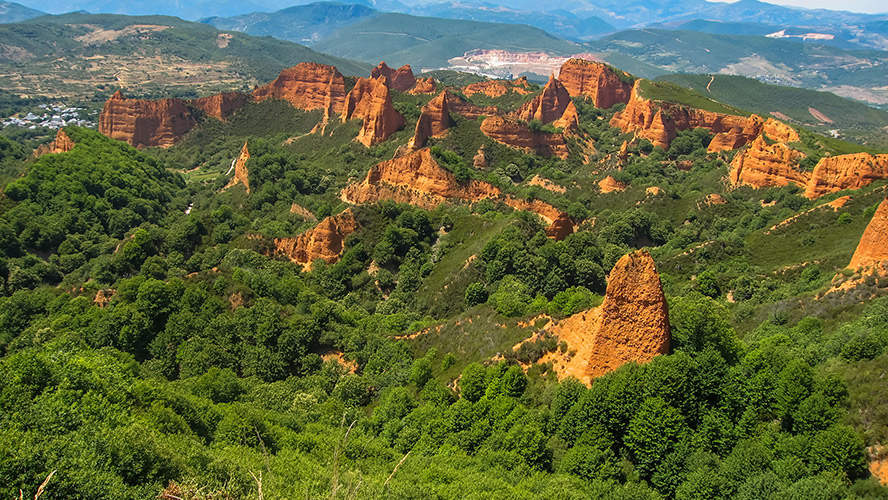
What to see in Las Médulas
In Las Médulas there are several marked routes that can be a good way to visit the area. Most of them will take you to the most famous viewpoints and caves.
The viewpoint
There are several viewpoints that offer an incredible view of Las Médulas but the most popular is the one at Orellán, where most visitors have their photo taken with the entire lunar landscape behind them. Although it is signposted, the best way to get there is to take a left turn from Orellán, on the road from Carucedo to Las Médulas.
From this viewpoint, you can see the reddish forms of the mountain that have been repopulated by oak and chestnut trees, giving a reddish-green mixture that has become the typical colour of Las Médulas.
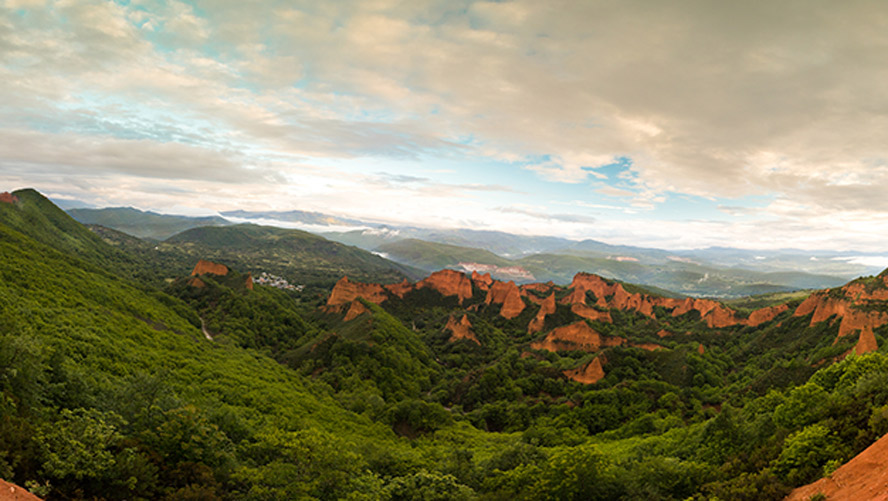
Orellán Galleries
Next to the viewpoint are the Orellán Galleries, one of the few attractions in Las Médulas where you have to pay to visit. With a ticket, you can walk through one of the tunnels that the Romans dug and filled with water to break up the mountain with hydraulic power. In addition, there is a small gallery of about 100 metres that leads to another viewpoint, where the landscape is just as breathtaking.
Saint Mary’s Monastery in Carracedo
Saint Mary’s Monastery is located in Carracedo and is considered to be one of the most important in the area. Founded by King Bermudo II in 990 for monks fleeing from Almanzor, the building has experienced both ups and downs.
In the 12th century, Sancha of León, sister of King Alfonso VII, built the rooms that are considered the most interesting today, as well as the Royal Palace and the Queen’s Viewpoint.
It is an interesting architectural work with various styles: late Romanesque, Gothic, Renaissance, Baroque and Neoclassical.

Routes in Las Médulas
Las Médulas offers the possibility of doing several routes on foot, either with a guide (some outings are offered at the visitor centre) or on your own. One of the best known is the Valiñas Trail, which passes by the fountain of Aunt Viviana and the caves of La Cuevona and La Encantada. It is a circular route that starts in the village of Las Médulas.
Another route is the Submerged Lake Trail, an ancient wash channel. This is a short and easy walk that leads to the Chao de Maseiros viewpoint. Along the way, you can enjoy the lakes formed by the natural drainage of the surroundings and the canals.
The Perimeter Trail is the longest but it covers all aspects of Roman gold mining and provides you with a better understanding of the phenomenon. Supplementing this route is the Convent Trail, which starts in Orellán and runs through the areas where the hydraulic network built by the Romans can best be seen.
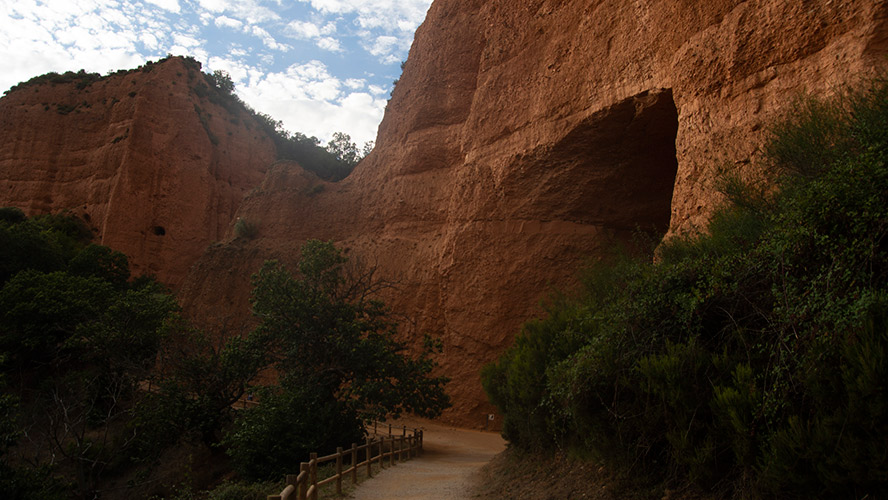
Where to eat in Las Médulas
There are several taverns and restaurants in the villages surrounding the Natural Monument such as Las Médulas, Orellán and Carucedo that provide traditional food menus.
One of the most popular is El Complejo Rural Agoga, very close to the visitor centre, where you can try the typical botillo sausage from the El Bierzo region.
Another option is Casa de Comidas Arcadio Travieso, in the village of Las Médulas itself, which has a balcony and, depending on the time of day, live music; or Mesón Durandarte, a short distance away, where they serve delicious local wine.
How to get to Las Médulas and information for your visit
The Natural Monument’s visitor centre is in the village of Las Médulas, so it is a good place to start the visit, finding out what you can see and how to do it.
The best way to explore the area is by car. Guided tours can also be booked at the visitor centre.
In any case, comfortable shoes are recommended as many of the routes are on foot.
The best time of the year to visit Las Médulas is in spring but, if you go in the summer, do not forget sun protection and a swimming costume as you can take a refreshing dip in some of the lagoons you pass through.
Things to see nearby
Las Médulas is very close to the most beautiful villages in the area. One of the musts is Ponferrada, with its Templar Castle and famous Clock Tower.
You can also visit several municipalities that developed under the shadow of the pilgrimage route to Santiago de Compostela and which maintain that medieval spirit such as Molinaseca and Villafranca del Bierzo, known as ‘little Compostela’ and where you could get the papal bull if you crossed its door of forgiveness and had travelled at least 100 kilometres of the pilgrimage route.
A trip from Las Médulas to the El Bierzo region is the perfect way to enjoy nature and history in equal parts.
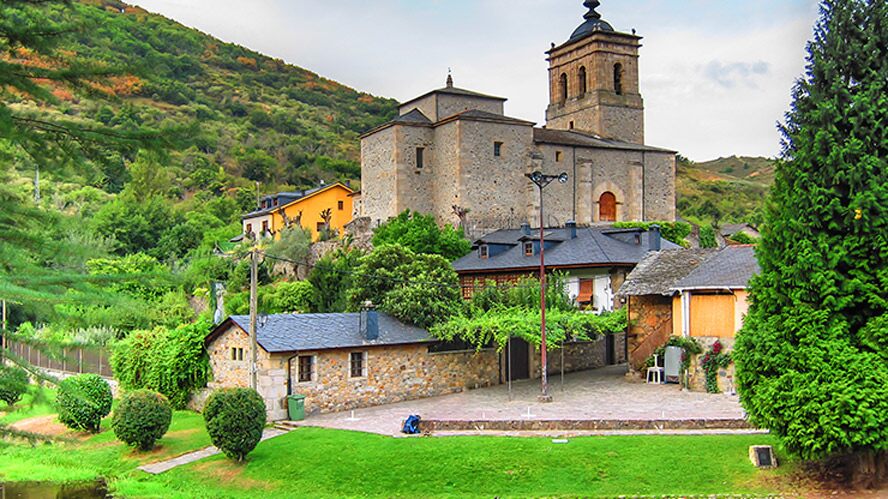
Where to stay in the province of León
In this case, one of the best options is the Barceló León Conde Luna, located in the heart of the city of León. This hotel has 136 bright, fully equipped rooms and a carefully selected buffet breakfast service to start the morning with energy. It is also a gastronomic reference since it has two of the most iconic restaurants in the city: Nimú Azotea, located on the tenth floor of the hotel, and Casa Mando.
Another option is the Occidental León Alfonso V, in the historic centre of León, within walking distance from Casa Botines, the cathedral and the collegiate church of San Isidoro. The hotel’s architecture is striking, with an impressive interior dome that rises imposingly from the reception to the eighth floor. The Occidental León Alfonso V has 62 cosy rooms and an exquisite breakfast.





























































